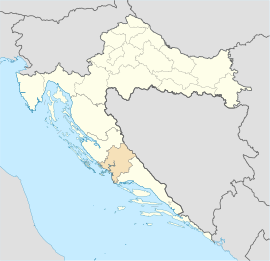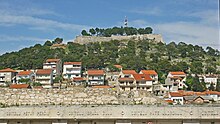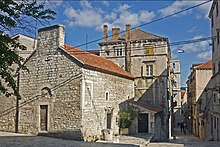Šibenik
| Šibenik | |||
|
|||
|
|
|||
| Basic data | |||
|---|---|---|---|
| State : |
|
||
| County : |
|
||
| Height : | 0 m. i. J. | ||
| Area : | 404 km² | ||
| Residents : | 46,332 (2011) | ||
| Population density : | 115 inhabitants per km² | ||
| Telephone code : | (+385) 022 | ||
| Postal code : | 22,000 | ||
| License plate : | ŠI | ||
| Boat registration : | ŠB | ||
| Structure and administration (as of 2017) |
|||
| Community type : | city | ||
| Structure : | 43 districts | ||
| Mayor : | Željko Burić ( HDZ ) | ||
| Coalition partner : | HSP AS, HSS, HČSP | ||
| Postal address : | Trg Pavla Šubića 2 22 000 Šibenik |
||
| Website : | |||
| Others | |||
| Patron saint : | Sv. Mihovil (St. Michael) | ||
 View of the cathedral and the bay |
|||
Sibenik [ ʃibɛnik ] (German obsolete Sibenning , Italian Sebenico ) is a town with 46,332 inhabitants (census 2011 ) on the Adriatic coast in the south of Croatia . It is located in the Šibenik-Knin County (Croatian Šibensko-kninska županija ) and is the seat of the Catholic Diocese of Šibenik .
The overwhelming majority of the population are Croatians with 94.62%.
geography
The city is located not far from the mouth of the Krka River into the Adriatic Sea on a naturally protected harbor that enters the sea through a 2.5 km long, natural channel-like breakthrough.
history
Šibenik was mentioned for the first time in 1066 in a document from King Petar Krešimir IV , who stayed in the fortified castle of St. Michael (today St. Anna). From 1116 to 1124 and from 1125 to 1133 Šibenik was under Venetian rule. The Hungarian-Croatian King Stephen III. Árpád gave the city autonomy in 1167. After a shorter term of office of the Byzantine ruling house (until 1180), the city was ruled alternately by the Hungarian-Croatian kings, Venice , the Bosnian king Stjepan Tvrtko and the duke Hrvoje Vukčić Hrvatinić .
From 1412 to 1797 Šibenik was again under Venetian rule. After that, until 1918, apart from the time of the French occupation, Šibenik was part of Austria-Hungary with the rest of Dalmatia .
On August 28, 1895, the first alternating current power plant was put into operation in Skradinski buk , on the Krka River, according to plans by Nikola Tesla . The city of Šibenik was one of the first cities in Croatia to be illuminated with electricity.
1914 Šibenik was as Garrison the kk Landwehr occupied by the II. Battalion of kk Landwehr infantry - regiment . # 23.
Towards the end of the First World War , Šibenik was occupied by Italy, but became part of the Kingdom of Serbs, Croats and Slovenes (later Yugoslavia) through the Rapallo Border Treaty in 1920 .
World heritage and architectural monuments
The most important building in Šibenik is the Cathedral of St. Jacob (Katedrala sv. Jakova), the roof of which consists of a barrel vault made of self-supporting stone slabs. The cathedral belongs to the list of World Heritage of UNESCO .
There are two national parks in Šibenik: Krka and Kornati.
Šibenik is a city of stairs with over 2,800 steps within its alleys. It has many sights and monuments.
Fortresses
The Venetian defense system with the four fortresses of Šibenik has been on the UNESCO World Heritage List since 2017.
- Fortress of St. Michael (Tvrđava sv. Mihovil) (60 m), also fortress of St. Anna, the oldest fortress in Šibenik, was built in the 11th century under King Petar Krešimir IV , today's appearance from the 18th century with four towers, renovated in 2014 and equipped with an open-air stage.
- Fortress of St. John (Tvrđava sv. Ivan) (115 m), design by the Venetian architect Antonio Leni, abandoned by the Turks in 1647.
- Fortress Baron or Fortress Šubićevac (80 m), named after the Venetian general Christoph Martin von Degenfeld
- Fortress of St. Nicholas (Tvrđava sv. Nikola), designed by the Venetian engineer Michiele Sammichelle, built in the 16th century at the entrance to the Antonius Canal (Sv. Ante) to defend the city from the sea side, also accessible on foot via the Sv . Ante.
Churches and monasteries
- Cathedral of St. Jacob (Katedrala sv. Jakova), the roof of which consists of a barrel vault made of self-supporting stone slabs, built between 1431 and 1535 by Giorgio da Sebenico (Croatian: Juraj Matejev Dalmatinac ) and Niccolò di Giovanni Fiorentino (Croatian: Nikola Firentinac ) ,
- Church of St. John the Baptist (Crkva sv. Ivan Krštitelj) on Zagrebačka ulica, built in the 15th and 16th centuries. Century in the transition style Gothic-Renaissance, on the unfinished bell tower there is a Renaissance window by Nikola Firentinac.
- Church of the Holy Spirit (Crkva sv. Duha), built in the 17th century according to plans by Antun Nogulović, with a wheeled window above the portal.
- Church of the Assumption of the Virgin Mary (Crkva Uspenie Bogomatere) with a baroque bell gable in Zagrebačka ulica, built from 1390, originally Church of the Savior (Sv. Spas) of the Benedictine monastery, used as an Orthodox church since 1810 (with iconostasis worth seeing).
- Franciscan monastery and church (Samostan i crkva sv. Frane) from the 16th century.
- Benedictine monastery and church of St. Lucia (Benediktinski samostan i crkva sv. Luce), founded in 1639
- Laurentius monastery and church (Samostan i crkva sv. Lovre) with the medieval monastery garden (Laurentius garden), restored in 2007 by Dragutin Kiš
- Dominican monastery and church (Samostan i crkva sv. Dominika)
- Nikolauskirche (Crkva sv. Nikole), the church of the sailors in the Renaissance style
- All Saints Church (Crkva Svih Svetih)
- Cross Church (Crkva sv. Križ), built by the Brotherhood of St. Mark
- New Church (Nova crkva), Renaissance building (15th / 16th century)
- Church of Our Lady outside the city - Church of the Nativity of the Virgin Mary (Crkva Gospe vanka grada - Porođenja Blažene Djevice Marije) (1740)
- Church of St. Gregory (Crkva sv. Grgura) on Jurja Dalmatinca Street, now a museum
- St. Barbara's Church (Crkva sv. Barbare) from the 15th century, now a Museum of Religious Art
- Church of St. Chrysogonus (Crkva sv. Krševana), now a gallery
Other buildings
- Old Town Hall - City Loggia (Gradska vijećnica - Gradska lođa) on Republic Square (Trg Republike), built 1533–1542
- Small loggia (Mala lođa)
- Zagreb Street (Zagrebačka ulica) with numerous town houses and aristocratic palaces
- Republic Square (Trg Republike) with the Dalmatinac monument by Ivan Meštrović (1961)
- City Theater (Šibensko kazalište), built in 1870
- Rector's Palace (Kneževa palača) of the Venetian rulers, now the city museum
- Bishop's Palace (Biskupska palača), built 1439–1441
- Šibenik Bridge over the Krka estuary
- The promenade and the remains of the city wall (Šibenski gradski bedemi) with the sea gate
- Four city fountains (Četiri bunara) and former water reservoir (15th century), now “Bunari” exhibition center and gallery
- Monument to King Petar Krešimiru IV. (Spomenik Petru Krešimiru IV.)
- Memorial Park Šubićevac (Spomen Park Šubićevac)
- Roberto de Visiani Park
- Juraj Šižgorić Library
Partnerships
Šibenik is twin town of the Herford district in North Rhine-Westphalia and the city of Voiron in France .
Cultural events
Since 1958 the "International Children's Festival" has been celebrated in Šibenik. The festival supports the artistic education of children and young people. Since 2011, the Terraneo Festival has been held annually in August in Šibenik on a former military site.
Sports
The club HNK Šibenik participates in the 2nd HNL , the second highest Croatian football league. The water polo VK Sibenik belong since independence of the strongest teams in the country and were repeatedly hosted international events. The sport is quite popular on the Adriatic coast.
The successful rowing club Krka , founded in 1923, is based here.
sons and daughters of the town
- Nikola Tavelić (approx. 1340-1391), Franciscan
- Andrea Schiavone (approx. 1510–1563), painter
- Fausto Veranzio (1551–1617), diplomat, clergyman, polymath and inventor
- Ivan Lukačić (1587–1648), composer
- Roberto de Visiani (1800-1878), botanist
- Niccolò Tommaseo (1802–1874), Italian poet
- Arsen Dedić (1938–2015), musician, poet, composer
- Ivo Deković (* 1952), painter
- Aleksandar Petrović (* 1959), basketball player and coach
- Dražen Petrović (1964–1993), basketball player
- Goran Višnjić (* 1972), actor
- Ivana Maletić (* 1973), politician
- Maksim Mrvica (* 1975), pianist
- Ivan Ergić (* 1981), football player
- Igor Cukrov (* 1984), singer
- Ante Rukavina (* 1986), football player
- Franko Škugor (* 1987), tennis player
- Antonija Sandrić (* 1988), basketball player
- Arijan Ademi (* 1991), football player
- Grgo Živković (* 1993), football player
- Duje Ćaleta-Car (* 1996), football player
Web links
- Harbor Sibenik (English)
- Cathedral Sibenik, World Heritage Site (English)
- Sights in Šibenik
Individual evidence
- ↑ 2011 census by nationality, ethnic group and mother tongue - Šibenik-Knin County , page 73, Croatian State Statistics Office , dzs.hr, accessed on January 1, 2020
- ↑ Šibenik Croatia - tourist destinations, information and attractions. Retrieved May 21, 2018 .
- ↑ Sights in Šibenik (accessed May 8, 2017)
- ↑ Tourist Board of the City of Šibenik - Sacred Monuments (accessed on May 8, 2017)
- ↑ Tourist Board of the Šibenik-Knin County (accessed on May 8, 2017)
- ↑ Šibenik Theater (accessed May 8, 2017)
- ↑ 56th Children's Festival 2017 (accessed on May 8, 2017)
- ↑ Terraneo Festival (accessed May 8, 2017)









